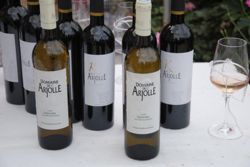 Paroles de vignerons - Vinparleur - Winzer talk
Paroles de vignerons - Vinparleur - Winzer talk
Latest update : 29 November 2019.

Dear friends,
now that the wines have achieved fermenting the last residual sugars, and we have decently celebrated the end of harvest at the Domaine de l’Arjolle, we may try a first review of the 2012 harvest.
We picked the first Sauvignon grapes at the Arjolle early in the morning on 22nd of August, followed by the other grapes for our white wines, Chardonnay, Viognier and Muscat Petits Grains a few days later. Favourable weather conditions during this first part of harvest, allowed us (...)
After three years of conversion to organic farming, we have picked this year our first organic grapes, certified by Ecocert. Having abandoned methods like chemical weed control more than 10 years ago, our work naturally evolved towards sustainable use of our farmland and environment. In 2010 we choose to install VITIFIL© on our estate for wastewater treatment. VITIFIL® collects, stores and processes the residual waters, before distributing them through an irrigation system to surrounding (...)
continueIt has been a vintage full of ordeals for many wine-growing regions in France. After the very hard frosts in February, budburst was quite heterogeneous in the Rhône valley. But due to “fertile” spring weather, full of rain and sunshine, vegetation caught up easily before flowering.
After a warm summer and dry weather in August, we started harvesting on September 17th. Ripe and well-balanced grapes allowed picking Syrah, Cinsault and some early ripening Grenache vineyards before the rainfalls (...)
The renewal of vineyards is part of the natural lifecycle of a wine estate. We recently pulled up two hectares of vines, whose leaf and fruit growing had become more and more aleatory over the last years. To compensate this loss, we have planted young Malbec on two hectares of stony and calcareous fallow land at the slopes above the domaine. As wines had not been grown in this spot for more than 20 years, the soil is free of viruses, offering an extremely healthy environment to the young (...)
continueThe renewal of vineyards is part of the natural lifecycle of a wine estate. We recently pulled up two hectares of vines, whose leaf and fruit growing had become more and more aleatory over the last years. To compensate this loss, we have planted young Malbec on two hectares of stony and calcareous fallow land at the slopes above the domaine.


On Saturday June 30th, the Domaine de l’Arjolle proposed to spend a “Gourmet Day” in the vineyards of the Côtes de Thongue and in the gardens of Château Margon, north of Pézenas. The program included nice weather, delicious wines and some local specials, prepared with care by the partners of the Arjolle: Fresh oysters from Bouzigues, cold cuts and smoked goose liver, tuna with ginger and spices, as well as an assortment of excellent cheese and some alluring deserts….
Oxygen is naturally found in wine. It is even helpful during fermentation and ageing. But enrichment of oxygen during the final preparation of the wine, between ageing and bottling, may provoke premature oxidation, as well as development of microorganisms. In this case, the wines seem to age quickly and loose a part of their aromas. Filtration and addition of sulphur go against this evolution, but you might as well prevent the wines from taking up too much oxygen.

Although one of the most planted grape varieties in the world (around 200.000 hectares), Grenache is still unknown to a great number of wine drinkers, being in the shadow of the star varieties for the last decades – Cabernet & Co. Probably originating from Spain (named Garnacha there), it spreads all across the Mediterranean area during the late 19th century, where it produces some highly renowned wines today: Gigondas and Chateauneuf-du-Pape in the Rhone Valley, Priorat and Rioja in Spain, the wines from the Languedoc and Roussillon area, Provence…
continue
0 | ... | 50 | 60 | 70 | 80 | 90 | 100 | 110 | 120 | 130 | 140
 Français
Français Deutsch
Deutsch English
English